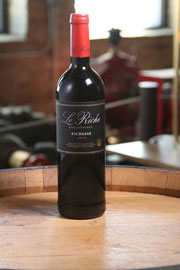- Analysis
- Vineyards
- Vinification and Aging
- Tasting Notes
- 2013 Vintage Notes
2013 Richesse
Wine of Origin
Stellenbosch
Varietals
36% Cabernet, 33% Merlot, 12% Cabernet Franc, 11% Petite Verdot, 8% Malbec
Analysis
Wine Maker: Christo Le Riche
Alcohol: 14%
Total Acidity: 5.7 g/l
pH: 3.73
Residual Sugar: 1.2g/l
Production:
The grapes are selected from top growers in Stellenbosch. A combination of soil, climate, clones and vine age determine the vineyard blocks selected. With meticulous viticulture and a focus on canopy microclimate and soil health, we try to ensure that each vineyard can express itself to its full extent. Vineyard blocks are vinified separately to determine their quality and style, ensuring that their unique character is understood and shown.
Within Stellenbosch, the majority of the fruit comes from two soil types – decomposed granite soils higher on the mountain slopes and sandy gravel on the valley floor. Most of our vineyards are close to the ocean, providing a cooling breeze in the afternoon during the hot summer months. These vineyards are also on sandy gravel soils that warm up fast during budding and provide us with earlier ripening grapes. The decomposed granite soils are mainly higher on the mountain slopes where the altitude helps to cool the vineyards. These soils bud and ripen later in the season. Other soils include decomposed shale and the warmer slopes of the Bottelary Hills.
The basic vinification involves the use of open top fermenters and manual punch downs under controlled fermentation temperatures. The berries are sorted after de-stemming and then go to open, lined concrete fermenters where inoculation with yeast takes place. Fermentation on the skins follows with regular manual punch-downs to ensure maximum color, tannin and flavor extraction.
The wines were fermented separately until dry in traditional open concrete tanks with regular manual plunging. Secondary fermentation proceeded in tanks after which the wines were moved to French oak barrels for 12 months. Blended after a year of aging and matured for a further 8 months in barrel. No fining.
The wine shows big red fruit flavors of plum and ripe red cherries, balanced with a touch of vanilla and baking spices on the nose. Juicy mouth filling flavors of red raspberry jam, fresh plums and smoky hints, are all supported by a soft tannin structure and a rounded finish. This wine would pair very well with a well marbeled cut of New York Strip or a roasted rack of lamb with fresh herbs
The season started with an early and even bud-break due to a cold and dry winter. Spring was cool and dry helping the vineyards to grow slowly and without pressure from disease. A cool October and early November had high rainfall levels (70mm) with intermittent winds that damaged the Cabernet flowers resulting in a smaller than usual crop due to weak fruit set. Mildew populations were prevalent and their pressure remained until mid – December.
The period after flower set to veraison was good with a warm and less windy December. This is the most important time for flavor development. We were able to open up the canopies and expose the berries to early sunlight, helping them to develop their own “sunscreen” for the summer with higher tannin production.
Low water levels persisted throughout the vintage, reducing the vine vigor and berry size. January had two heat waves with temperatures of over 35°C, but it was early enough in the season for the Cabernets to recover. This warm weather also helped to reduce green flavors. A cool February slowed the berry ripening and resulted in a harvest that started 1-2 weeks later than usual. This assisted in developing good fruit and tannin ripeness at lower alcohol levels with good acidity.

